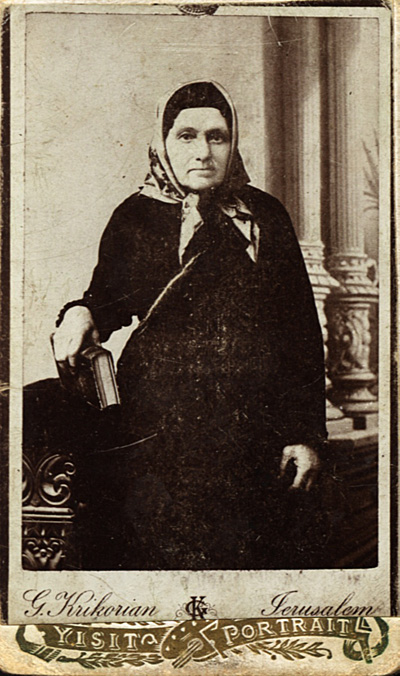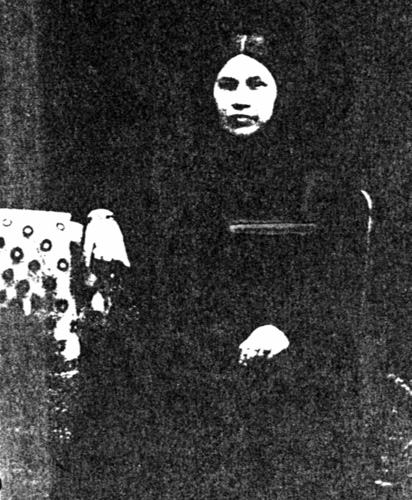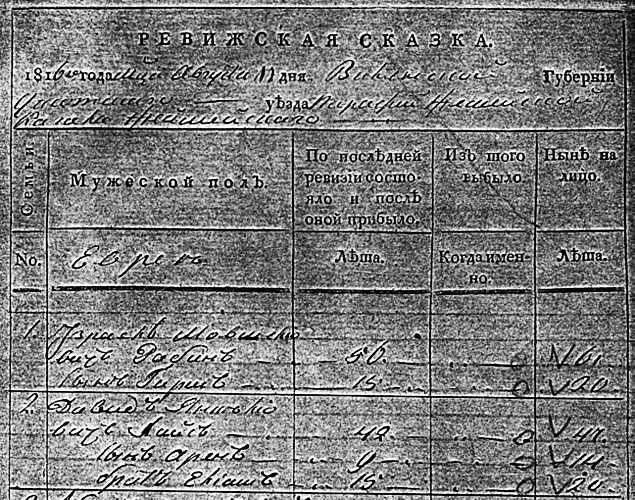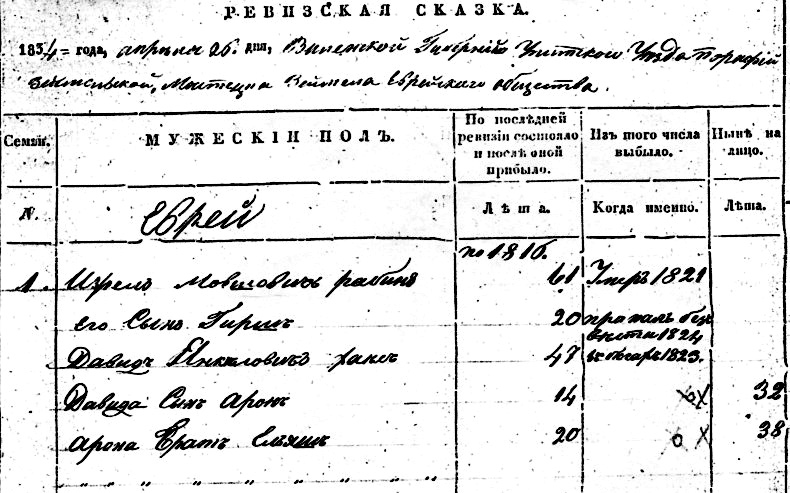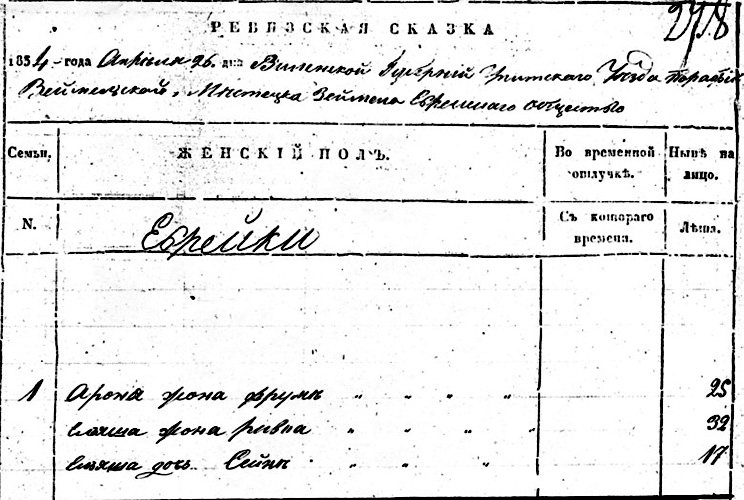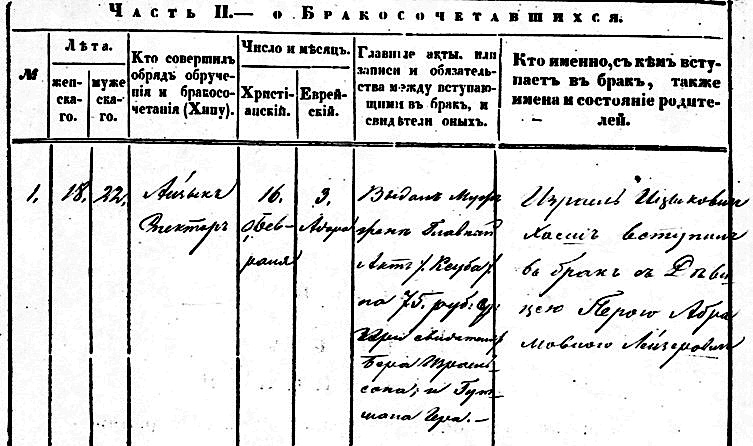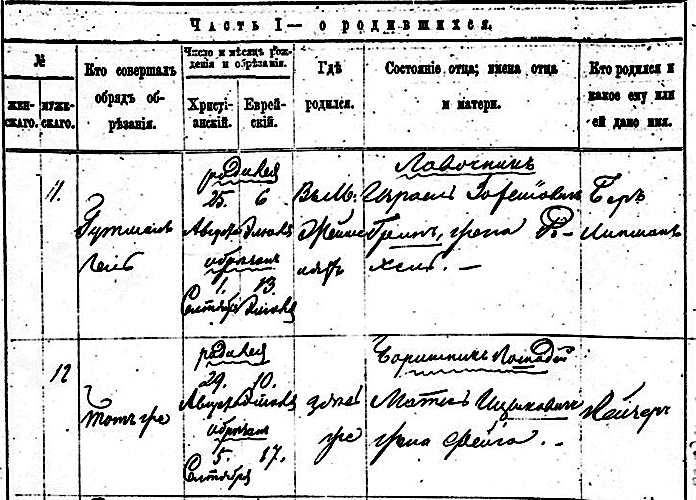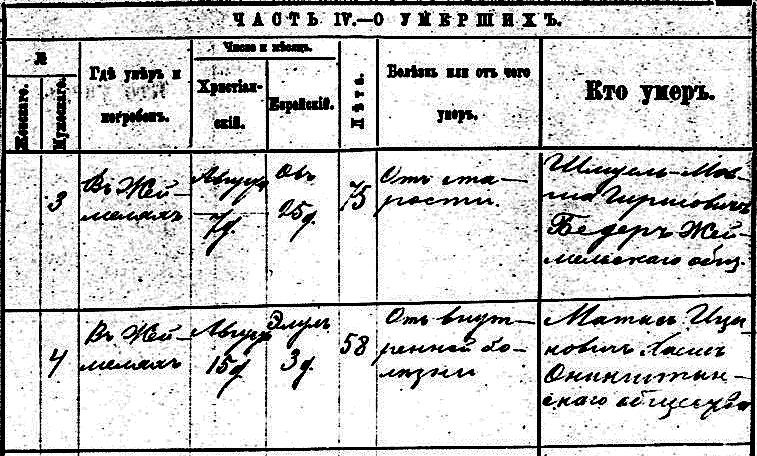Anatolij Iljich Chayesh
THE CHAYESHES
Biographical and genealogical data
Chapter 2. Genealogical List of the First Three Generations [1]
The translation from Russian was done by Olga Muranova
Progenitor
1. Chajs, or Chaes, Jankel.
We don’t have any documents about Jankel himself; however, his surname and name are ascertained on the basis of the census lists of his son – David Jankeliovich Chajs, or Chaes, who was born in 1769 [2]. As Jankel hardly could become father till the time when he was 14 then, probably, he was born before 1755.
First Generation
2. Chajs, or Chaes, David Jankeliovich [3] 1 [4]
David is my great-great-great-grandfather and the first member of the family, about whom we managed to find archival documents. According to the census list which was compiled in the Zheimel kahal, belonging to Upitskij uyezd* of Vilenskaya guberniya in 1816 David Jankeliovich Hajs was 47. It means that he was born in 1769. He was considered to be one of the members of this kahal even according to the previous census which was conducted in 1811. According to the same census list, David’s wife, Peshe, was 2 years younger than her husband. So she was born in 1771. They had four sons: Eliash who was born in 1796 [5], Aron who was born in 1802, Gabriel who was born in 1804 and Itsik who was born in 1809 [6].
In the census list of the same kahal, which was compiled in 1834, it is pointed out that David Jankelevich Haes had been “in hiding since 1823” [7]. Peshe is not mentioned there. Perhaps, she was in hiding together with her husband. We don’t know anything about their further destiny.
Second Generation
3. Chajs, or Chaes (Chaesh) Eliash or El’jash and Elijash Davidovich [8] 2
According to the same two census lists Eliash was born in 1796 [9]. The census list of 1816 says that his wife Rivke was one year younger than her husband [10]; that is she was born in 1797. Both of them were registered in Zheimel kahal in 1811 too. They had three children. Their son Abram was born in 1808. Besides, they had two daughters: Chaya-Sora who was born in 1812 and Sejna (Shejna) who was born in 1815 [11].
In the census list compiled in 1834 Eliash, Rivka and Seyna are included in the family of Izrail Movshovich Rabin who died as far back as in 1821. The list itself is concluded with the following text: “Then now we have one hundred and eighty two male Jewish souls and three hundred twenty six female souls. The plenipotentiary of Zhemel society guarantees that in this census list of April 26, 1834 all real souls are shown, there are no propisnyije (that is false data) about them. Signed by Elijash Davidovich Chaes”.
Thus Elijash Davidovich Chaes was skazkosostavitel’ (that is he was occupied with compiling census lists). It means that he was one of the most respected members of the kahal. It may be assumed that he knew the Russian language to a certain extent as the list is written in Russian. At that time only a few people knew this language in Lithuania. Certainly, El’jash enjoyed the confidence of the uyezd administration. Otherwise he wouldn’t be given the work which assumed assessing taxes imposed by the exchequer.
In spite of this situation no property remained after the death of Eliash Davidovich Chaesh in 1836 when he was 40 years old [12]. Therefore all the arrears to the exchequer, which were imputed to him, were supposed to be paid out from the money collected during the process of levying box-tax [13]. We have no notion of Rivka’s destiny after 1834.
4. Chajs, or Chaes (Chaesh) Aron Davidovich [14] 2
According to the same two census lists Aron was born in 1802. According to the census list of 1816 his wife Mine was one year older than her husband. That is she was born in 1801. Both of them were registered in Zheimel kahal in 1811 too. According to the census list of 1834 Aron had another wife – Fruma who was 7 years younger than he. So she was born in 1809. Both of them are also included in the family of Izrail Movshovich Rabin. In the census list of 1850 it is pointed out that Aron “disappeared without a trace in 1847” [15]. We have no idea of Aron’s and Fruma’s further destiny.
5. Ches, or Chais Gabriel Davidovich [16] 2
According to the census list compiled in Zheimel kahal in 1818 Gabriel was born in 1804; his name was omitted in the previous census list which was prepared in 1816. In the census list of 1834 it is pointed out that he died in 1826 (at that time he was 22).
6. Ches, or Chais (Chaesh) Itsik Davidovich [17] 2
Itsik is my great-great-grandfather and the first member of the family, about whom fragmentary memories of his descendants have been preserved.
However, let start with the documents. According to the census list which was compiled in Zheimel kahal in 1818 Itsik Ches was 9. So he was born in 1809. He was considered to be a member of the family of his elder brother Gabriel. His name was omitted in the census list of 1816 as well as the name of Gabriel. According to the census list of 1834 Itsik Chais was married to Itke who was of the same age (she was born in 1809), their daughter Meriem was born in 1828. All of them were considered to be members of the family of Itsik’s elder brother – Gabriel who had already died by that time (see above ¹ 5).
According to the census list of 1850 [18] Itsik Davidovich Chaesh was 41 years old, and his wife – Ejda – was 29 years old (she was born in 1821), his daughter Dinah was 18 years old (she was born in 1832), and his son Izrael was 10 years old (he was born in 1840). It is quite obvious that Dinah couldn’t be Ejda’s daughter who was 11 in 1832. Thus Dinah is Itka’s daughter as well as Meriem. Apparently, Izrael was Ejda’s son as eight-year interval between the birth of Meriem and Izrael prompts that at that time Itsik’s first wife – Itka – could be ill during long time before she died. Probably, by tradition Itsik was a widower approximately during a year, and by 1839 he got married to Ejda who bore him Izrael in 1840. Soon other Itsik’s children appeared. They are mentioned in the registers of births of that community: Eliah-Mates [19] who was born in 1842 [20], and Ber who was born in 1848 [21]. It is significant that these two sons were not registered in the census list of 1850 although the first of them was already eight years old, and the second – two years old. It may be assumed that the community wanted to decrease its burden of taxes when its members tried to avoid the necessity to register under-age children.
Their next son – Wolf – was born in 1859 [22]. Later they preserved the record which was left in the registers of births of Zheimel on February 17, 1860. This record said that the Jewish agriculturalist [23] Itsik Davidovich Chaesh got a son whose name was Gavriel [24]. Ejdo was the mother of the new-born child. Perhaps, Urjash Itsikovich Chaesh and Pejsah Itsikovich Chaesh are also Itsik’s sons. However, we don’t know their dates of birth [25].
On May 28, 1852 Itsik Davidovich Chaesh received a certificate which was necessary for getting an annual passport from Ponevezh rathaus (that is Ponevezh town council). The passport let him leave that place for earning money. It is important to point out that his son Izrail got permission for two-month absence in January 1953. Perhaps, he needed to accompany his father and to participate in his affairs.
On September 7, 1853 Itsik received a certificate for getting an annual passport once again. Apparently, in summer 1853 (June-August) he was living at home although it is not inconceivable that receiving the passport in Ponevezh rathaus took place by no means not after giving the certificate. Then duration of Itsik’s absence which corresponds with the period of validity of his passport is less definite. On December 27, 1854 Itsik received a certificate for getting an annual passport once again. Thus, perhaps, that time he was living at home (in September-December 1854) [26].
It is important to emphasize that in 1860 Itsik Davidovich was called an agriculturalist. In 1863 Itsik Davidovich Chaesh living in “Salatskij parish in the estate of Kumyanyi” was registered in the “List of Jews Belonging to the Community of Zheimel, Who Don’t Pay the State Taxes”. On November 4, 1863 the tax collector Jankel Klavanskij sent this list to the pristav of the second stan** of Ponevezh uyezd. In the report accompanying the list Y. Klavanskij wrote the following: “On the reverse side there is the list of Jews belonging to Zheimel community, who don’t pay the state taxes, who live in different places of Ponevezh and Shavel uyezds and who haven’t visited the tax inspector of the community for paying their state taxes and other dues, arrears of the previous years and assessment of this year (i. e. 1863) to this very day. I have the honour of asking you humbly to connect with the necessary people. At the same time I would like you to give a strict order to the tyisyatskijs of the camp which you are responsible for to expel Jews living in that stan not later than on November 7. They shouldn’t give them any free time at all. On the same day I will be in the stan quarters for getting the state taxes and providing them with tables” [27].
From the report we find out that at that time Itsik was living in the small village called Kemyanyi. He had either difficulties with money or some other reasons preventing him from paying his taxes. Nevertheless, it was not surprising as that year there was a full-scale rebellion in Lithuania and Poland. However, in the list only 18 people are registered. It is only a small part of the community.
Since Itsik’s son Wolf died in village Kemyanyi of Kiburgskaya volost’ which is situated not far from Zheimel [28] it is clear that Itsik’s family were living them at least in 1863-1865.
Ejdo who was mentioned above was the second wife of Itsik, but not the double name of his first wife “Ita-Ejdo” – as in 1859 Ita would be 50 years old already, and that would be too much for bearing Wolf and Gabriel who had one-year difference in their age. This is what her descendants say about her.
My father’s cousin, Tsilja Chaesh, told me in 1982 that according to the family legend “great-grandmother was a very orthodox Jewess, she left all her children when they were already self-dependent. She left for Palestine. Then her youngest grandson Aron went to her” [29]. Tsilja didn’t know her name. However, she preserved a photo of her great-grandmother and my great-great-grandmother, which had been taken in the studio “G. Krigorian, Jerusalem” [30] before the revolution (Fig. 1). In the photo one can see a round-faced woman who is 50-55 years old. She is clothed in a dark dress and an elegant kerchief tied under the chin. She is standing against the background consisting of some drawn decorations usual for the studios of that time; she is not tall. She has a short neck, rather big nose, plump lips, in her right hand she is holding a prayer book which she is leaning against the decorative table. It is obvious that this woman is similar to Tsilja herself and to my father.
Figure 1. Ejda Izraelson, the author’s great-great-grandmother.
Daniel Chajuss and his relatives assert that in 1885 Aron’s grandmother left for Palestine to die there. She wanted to be buried on the Maslichnaja mountain [31]. She went to Palestine joining her brother and his grandson. Aron who was 13 at that time went together with her. He was her youngest grandson, none of the members of the family wanted to leave for Palestine, except him. She and her brother had been traveling around Western Russia for a year to obtain blessing from different rabbis, and then they came to Palestine. However, more detailed and trustworthy information connected with these facts is presented by Aron himself in his book “63 years in Jerusalem” [32]:
“When I was twelve my grand-uncle (the brother of my father’s mother) rav Moshe Izraelson decided to go to Palestine. My grandmother decided to go there too as she wanted to spend the last days of her life in Palestine. As my grandfather wanted to take one of his grandsons, my grandmother decided to take one of us too. Our father agreed with this decision at once, he said that he wanted to go there as well, but he had a family and it was impossible. All my brothers were afraid, and I got inflamed to go to Palestine (at the age of 12.5). At first my mother objected to it, but rabbi Kook managed to persuade her.
My grand-uncle was one of the richest house-owners in Bausk and a great friend of gaon r. Mordehay Eliyasberg, the rabbi of Bausk. Grandfather Moshe decided to go round different cities before the trip. First of all, these were Minsk and Vilna. There he wanted to consult with some renowned sages. At the same time he wanted to visit the graves of those people who had already died. The trip took 3.5 months. With many adventures the ship which was called “Nahimov” came to the coast of Palestine. There, beginning from Haifa, my grandfather and I started to travel round the country and pray at the graves of the famous rabbis” [33].
According the story told by Aron his grandmother’s maiden surname was Izraelson, and she, probably, came from Bausk. Before her departure to Palestine she, undoubtedly, became a widow, otherwise she couldn’t leave her husband; that is Itsik died before 1889. Later this supposition proved to be true. In February 2002 I received a copy of the registration statement “About the death of Itsik Davidovich Chaes at the age of 85, which took place in Zheimel on February 13 (Adar 18) 1883 and which was caused by his old age” [34].
Aron’s story lets us specify the year of the departure. Since Aron was born on February 13, 1877 he was 12.5 years old in 1889, and this year of the departure is more probable than the year 1885 as Avraham-Itshak Kook was the rabbi of Zheimel in 1889 [35], but not in 1885.
Then Aaron writes that formerly his grandmother was relatively tolerant woman, but in Jerusalem she became very religious. She considered that it was necessary just to pray. Aaron studied correct Arabic with some rabbi, with whom Arabian children studied as well. They understood oral speech, but couldn’t write. Aaron wrote in Arabic better than they. He was a clever boy and very soon he improved his knowledge of Arabic. His grandmother prohibited him to communicate and to study with Arabian children, she considered that it was a bad occupation. Her character became harsher, it was hard to get on with her. One could feel that gradually their relations became not very peaceful [36].
Third Generation
7. Ches, or Chais (Chaesh) Abram Eliashevich [37] 3
According to the census of Zheimel kahal in 1818 Abram Eliashevich Ches was 10 years old. So he was born in 1808, was considered to be a member of the family of uncle Gabriel (see above ¹ 5); his name was omitted in the census list of 1818 as well as it was with uncle Gabriel. According to the census list of 1834 Abram El’jashevich Chaes was 26, his wife Libe – 25. It means that Libe was born in 1809. Their daughter Blume was born in 1828. According to the census list of 1850 Abram died in 1847 [38]. So when he died he was 39 years old. We don’t know anything about further destiny of Libe and Blume.
8. Ches Chaja Sorya [Eliashevna] [39] 3
According to the census list of the same kahal in 1818 Chaja Sorya was 6 years old. So she was born in 1812. As a sister of Abram Eliashevich she is considered to be a member of the family of their uncle Gabryiel. We don’t know anything about her further destiny.
9. Ches, or Chaes Shejne Elyashevna [40] 3
According to the census list of the same kahal Shejne was 3 years old in 1818, that is she was born in 1815. As a sister of Abram Eliashevich she is considered to be a member of the family of their uncle Gabriel. According to the census list of 1834 her name is Sejna and as a daughter of El’jash she is considered to be a member of the family of Aron Davidovich Haes. We don’t know anything about her further destiny.
10. Chais Meriem Itsikovna [41] 6
According to the census list of the same kahal of 1834 she was 6 years old. So she was born in 1828. We don’t know anything about her further destiny.
11. Chais Dina Itsikovna 6
According to the census list of 1850 she was 18, so she was born in 1832. We don’t know anything about her further destiny.
12. Chaesh Izrael Itsikovich 6
The first documentary record of Izrael was found in the census list of 1850. According to this list he was 10 [42] at that time. It means that he was born in 1840.
The next document about him is a record in the “Book of outgoing papers” of the Jewish community of Zheimel. This record says that on January 24, 1854 Izrael Itsikovich Chaesh was given a certificate for getting a two-month ticket in Ponevezh rathaus [43]. This ticket let Izrael leave the shtel for two months. At the time of the Crimean war and wild lawlessness of hapuns (that is scroungers) it was extremely dangerous to leave the shtetl without passport or ticket. By that time Izrael was already 13 (it is the full age of the Jewish youths), and he could help his elder relatives with their affairs outside Zheimel.
However, by the time of his marriage Izrael grew three years “younger”: in the register of births of Zheimel it is written: “February 16, 1865. Izrael Itsikovich Chaesh got married to the girl whose name is Pera Abramovna Lejzerovich. In the presence of witnesses the husband gave his wife the Main Act (Ketuba) which guarantees getting 75 silvery rubles by his wife in case of their divorce. The witnesses were Ber Izraelson and Gutman Ger. The husband was 22 years old, and his wife was 18” [44]. So according to this certificate Izrael was born in 1843, and Pera – in 1847.
Having looked through all the registers of birth of Zheimel, which were available in Vilnius in 1992, I did not find any registration statement saying about the birth of children of this married couple. At the same time if we take into account the patronymic name of the Chaeshs registered in other statements Izrael’s children could be: Tsipa, Abel-El’jash who was born in 1870 [45], Jankel who was born in 1876 [46], Shejna-Ita who was born in 1882 [47] and Idel. Probably, Izrail died before 1908 as that year Tsipa bore the son whose name was Izrail [48], or even before 1903 as that year Abel-El’jash got the son whose name was Izrail [49].
I didn’t have any other data about this married couple.
However, as early as before October 10, 2000 while describing his family tree Elliot Blumberg wrote to me that “David Blumberg who I shell call No. 1 since he was the older and came to South Africf with his cousin Harry. David No. 1 was not a son of Elijahu-Matisjahu whereas Harry was a son Elia-Matis” [50].
Relying on this report given by Elliot Blumberg I decided that David ¹ 1 (David Blumberg) was the son of the brother of Harry’s mother; that is he was the son of his mother’s brother. It enabled me to assume that Fejga was the wife of Elia-Matis and mother of Harry (see below) and that her maiden surname was Blumberg. As for David ¹ 1 whose original surname was Blumberg and his descendants I was not very interested in researching their genealogy.
However, not long ago I had to change my views.
On July 28, 2006 I received an interesting letter written by Carlene Blumberg. There she mentioned that her husband’s great-grandfather was I. Blumberg (earlier – Chaesh) and that the name of his wife was Fanny: [1] “1. My husband's great-grandfather was I. BLUMBERG (formerly CHAIES) and his wife's name was FANNY”.
2. My husband's grandfather was DAVID, who was born in Zemil (Latvia or Lithuania?) on April 28, 1872. David emigrated to South Africa in approximately 1900 and remained there until his death in 1940” [51].
It is necessary to add here that due to my second cousin Tsilja Rokmann living in Izrael (see below) even earlier I knew about the fact that those Chaeshs who emigrated to South Africa changed their surname into “Blumberg”. After Carlene’s letter it became clear that David I. Blumberg (earlier – Chaesh) is undoubtedly our relative; however, it was not clear how “to fasten” him to the genealogical list. I asked Carlene to send me the birth certificate of David Blumberg. She did not have it, but she sent me a copy of the death certificate of David Blumberg in 1940. There it was pointed out that his father was Izrail Blumberg and that his mother was Fanny Blumberg.
Then I got a supposition that David’s father could be Izrail Itsikovich Chaesh. Brief information about him is presented in this article. However, in 1865 the name of Izrail’s wife was Pera, while the name of David’s mother (David was born in 1872) was Fanny. Nevertheless, Fanny could be Izrail’s second wife, or she could have a double name Pera-Fanny.
In this connection I reread Eliot’s letter. Thus I found out that after David ¹ 1 his brothers Charles, Abba, Louis, Isaak, Idel and his sister Sarah (after the marriage her surname was Meyer) followed him and emigrated to South Africa [52].
In her turn Carlene informed me that David had three brothers: Charley, Louis and Judel (all of them emigrated to South Africa approximately in 1900) and three sisters: Sarah Meyer, Zelda Viguzen and Tsilja Chaesh. The first of them emigrated to Africa too [53].
Finally on January 28, 2007 I received new archival materials about Izrael Chaesh and Pera from Barry Mann. It turned out that Idel Chaes was born in Zheimel on June 17, 1881. Births of three other children were registered in Linkuva which is situated near Zheimel. Probably, that family moved there after 1881. On December 21, 1883 Shejna-Ita was born, on February 26, 1885 – Fruma Zelda and on April 3, 1888 – Abram-Itsik.
Let’s make a comparative table consisting of the data which are available at present (coincidences are typed in bold):
|
Member of the family |
According to the data given by Elliot Blumberg |
According to the data given by Carlene Blumberg |
According to the materials containing in the archives of Lithuania |
|
Father |
|
Izrail Blumberg |
Izrail Chaesh (born in 1843) |
|
Mother |
|
Fanny or Vera Mer |
Pera Abramovna Lejzerovich (born in 1847) |
|
Daughter |
|
Tsilja Chaesh |
Tsipa Chaesh (after the marriage – Haesh) |
|
Son |
|
|
Abel El’jash Haesh (born in 1870) |
|
Son |
David Blumberg |
David Blumberg, earlier Haesh (born 1872) |
|
|
Son |
|
|
Jankel Chaesh (born in 1876) |
|
Son |
Charles |
Charley Blumberg (born in 1879) |
|
|
Son |
Idel |
Judel |
Idel Chaes (born in 1881) |
|
Son |
Louis |
Louis (born in 1882) |
|
|
Daughter |
|
|
Shejna-Ita Chaesh (born in 1883) |
|
Daughter |
|
Zelda (after the marriage – Vigushen)
|
Fruma-Zelda Chaesh (born in 1885) |
|
Son |
Abba |
|
Abram-Itsik Chaesh (born in 1888) |
|
|
Isaak |
|
|
|
|
Sarah (after the marriage – Meyer)
|
Sarah (after the marriage – Meyer)
|
|
All these numerous coincidences let us understand that Elliot and Carlene enumerate members of one and the same family, but none of them know all its members.
If we sum up collected data we will see that Izrail Itsikovich Chaesh had 12 children: 8 sons – Abel-El’jash, David, Jankel, Charles (the last name is obviously Anglicized), Louis (probably, Lejba), Isaak, Idel, Abram-Itsik and 4 sisters – Tsipa (Tsilja), Shejna-Ita, Sarah and Zelda. (See more details about them in Chapter 5 ¹¹ 34-45).
13. Chaes, or Chaies (Haesh) El’jash-Mates Davidovich 6
El’jash-Mates is my great-grandfather. His real name is engraved on the tombstone. This name is Elijagu-Matisjagu. However, it is not fixed in the Russian documents. Therefore I use the brief form of this name – El’jash-Mates. These documents are not the only thing which has been preserved in connection with him. The recollections of his son – Aaron – were published as well. Tsilja Haesh who was mentioned above knew some data connected with her grandfather. Therefore the story about Mates will be much more detailed than the previous ones.
Different variants of spelling his last name have been already described. As for his first name my father said the following: “My name and the name of Max [54] were given after our grandfather. His name was Elja-Matis. It was quite usual for Jews to give names after grandfather who had already died. His exact name was Elja-Mates. Pretty often Jewish children were given double names. The second name was given particularly often after some serious disease as they believed that it could save their lives. Elja is the same as Ilja” [55]. Other variants of my great-grandfather’s name will be mentioned below.
For a long time nobody knew what year Mates was born. I supposed that he was born in the late 1830s – as the name of Mates was not included in the census list of 1834, and his wife Fejga who was, probably, younger than her husband was born approximately in 1843 [56]. Only in 2002 I found out that Mates was born in 1842 [57]. Their eldest son was Lejzer, my grandfather [58].
The birth of the first-born was an event which his parents registered officially. It was in 1992 when in the register of births which is kept in the LVIA I found a record saying about the fact that in Zheimel Mates Itsikovich who was a baryishnik (that is a horsedealer, or a horsejobber) and his wife Fejga got their son Lejzer [59], or, rather, Eliezer (the second variant was stated in the parallel record written in Old Hebrew) on August 29, 1867. However, some doubts are cast upon the accuracy of that date as Fejga bore twins; however, the second boy died [60], but for all that nothing is said about this fact in the register of births, which was mentioned above.
Horse-jobbing as a Jewish trade was forgotten long ago. I will quote you an answer to the question asked by the Minister of Internal Affairs N. P. Ignatjev. This answer came from Kovna in 1881. The question was the following: “What aspects of economic activity of the Jewish people influenced everyday life of aboriginal population of Kovenskaya guberniya?”.
The answer was: “In most cases horse-jobbing is … in the hands of Jews or at least Jews are middlemen or factors.
Being occupied with exchanging horses Jews don’t shun any means helping them deceive the customer.
Living in secluded places the baryishnik gets into contact with the horse-thieves; mostly Jews don’t take part in this illegal business in person, but direct actions made by the horse-thieves and accept those horses which have been stolen to resell them later. At the same time they buy these horses for a trifling sum. It is extremely difficult to establish the guilt of such a baryishnik if we consider his extensive relations with local residents, his resourcefulness and relative easiness of concealing his crimes. Although their trade is not a secret these people make a strong impact on the people living in surrounding precincts and inspire fear. Being afraid of revenge peasants are not determined to establish the guilt of this baryishnik who is the leader. The evidence against Jews resulted in arsons and thefts of the witness’s property.
It was not uncommon when the horses which had been stolen were returned to their owners if the latter gave some money to those people who organized these thefts of horses.
Stealing horses was quite wide-spread on the territory of Kovenskaya guberniya. However, we should take into account the following facts: usually peasants were settled not in villages, but in the settlements where only one family lived; at the same time it was very comfortable and profitable to sell stolen horses abroad – to Privislyanskij Kraj (Polish Realm) and Kurland. Then it is clear that stealing horses could not get become so popular if this trade were not organized properly. Jews- baryishniks were the main participants of this process” [61].
We don’t know if Mates took part in organization of this trade. However, the fact that he knew about this trade, its rules and customs as he was a horsejobbler is beyond any doubt.
In 1868 Mates and Fejga got their second son – Movsha. I did not manage to find any record of his birth [62]. Perhaps, it was not registered as getting the second son they faced the prospect of recruiting. At the same time if a person was the only son in the family he was not taken as a recruit.
At the beginning of 1869 Mates got a daughter. Her name was Mera. We know about it not from the record of her birth which is, probably, even not registered, but from the record saying that two-years-old Mera Mateshovna Chaesh [63] died in village Libets on May 27, 1871 because of fever. She was buried in Zheimel on May 30 as Libets or, rather, Libedzi was a small village belonging to Natsunskaya volost’ as well as Zheimel. Libedzi was situated at the brook which was called Planit; there was no Jewish cemetery in the village [64].
In June 1871 (that is almost immediately after the funeral) Fejga bore another son. The boy was given the name Girsh. They did not register him (or, perhaps, they did not have enough time for that). We know about this fact because of the record saying that on September 16, 1871 three-months old Girsh Mateshovich Haesh died in Salatskij parish because of fever. On September 19 he was buried in Zheimel [65].
Another archival record says that the inn-owner Matser Itsikovich Chaesh and Fejga got the son whose name was Girsh. Girsh was born in the same village Libedzi on November 27, 1874 [66]. It is evident that his parents appreciated this name. Now Mates had another trade – his own inn (or “korchma” in Russian). Nevertheless, he could continue his occupation with horsedealing as well.
Korchma (archaic) – is an “establishment where people could try or buy different alcoholic drinks; at the same time there was a coaching inn. Every korchma had a common room, two rooms for the guests staying there and a stodola (it is a spacious shed for carts and horses)” [67].
The literature on the Jews who were inn-owners is very extensive. This is one of the quotations found there:
“In the guberniyas taken from Poland and added to Russia Jewish people lived in different uyezds in excessive quantities… taking active part in producing and selling vodka. This situation became the result of the historical development of Jews in Poland where cities tried to get rid of the Jews who were their competitors in every possible way – as these cities considered trade and practicing crafts their privilege. Thus those Jews left for the uyezds against their will. There they were given a cordial welcome by local landowners. Jews were leased different pats of local economy out. Among other things it could be producing and selling vodka. These things were among the most important sources of income of landowners and the whole state. At the same time they became the main source of sustenance for the Jews living in the uyezds … due to the events accompanying divisions of Poland trade and farming fell into decay in Polish guberniyas. Then the profit coming from consuming vodka became even more vital… and as the right of distilling didn’t belong to the Jewish people Jews were just middlemen between landowners and peasants. So they were just leasers and inn-owners in the private and state estates” [68].
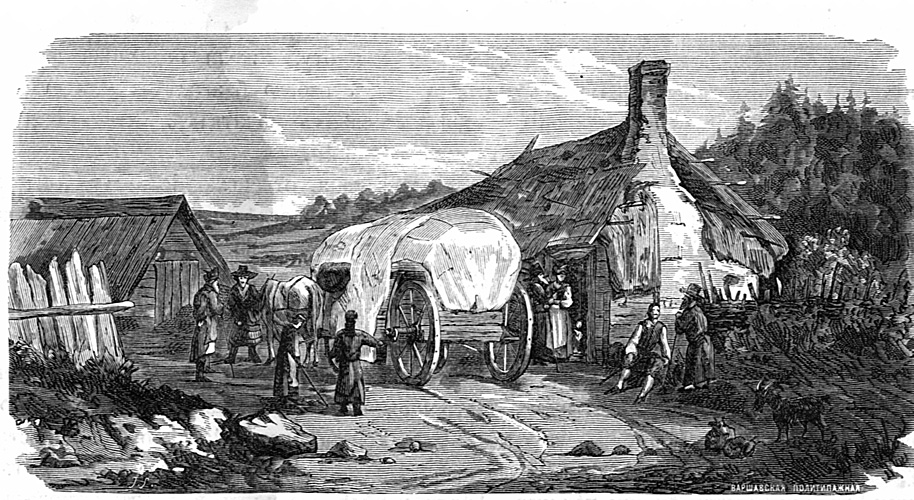
Figure 2. Lithuanian Jewish korchma
In village Libedzi, near the country-track, the korchma existed even in 1816 when Lejzer Ioselevich Man was registered there according to the census. Perhaps, in the 1870s it passed into the hands of Mates Chaesh.
The last record says about the fact that on February 13, 1877 in the same village Libedzi El’jash Mates Itsikovich Chaes from the Jewish community of Zheimel and Fejga Morthelovna got the son whose name was Orel [69]. This Orel was the same Aaron who left for Palestine together with his grandmother. He was the only man who knew Mates personally and whose memories we are familiar with.
In the book “63 years in Jerusalem” mentioned above Aaron writes that when he was born his family lived in “Zemelhof”. This German name can be translated as an estate, patrimony or manor Zheimel [70]. When Aaron was 8 months old that is in October or November 1877 there was a fire in the house. The kid was saved by a miracle as he was thrown from the window into the deep snow near the house. The house burnt down, and the family moved to shtetl Zheimel [71].
There they took up their residence in the small single-storey wooden house which stood next to the synagogue. According to the recollections of aunt Tsilja and her nanny, Rahil Kretsmer, the wife of Mates – Fejga – bore 13 children: Lejzer who was one of the twins, however, the second of them died, Moisej, Isaak, Girsh, David, Aaron, Frida, Ella, Roza and, besides, “there was some other brother who fell in love with an actress. She was unfaithful to him, and finally he committed suicide” [72].
In December 2006 Barry Mann [73] retold me the main content of registration statements saying about the birth of Ella and Isaak. According to these documents Elka Chaesh (in this way her name was written in the record) was born in Zheimel on April 28, 1883 [74], and Itsik Chaes (in this way his name was registered in the record) was born in Zheimel on October 22, 1886 [75].
Finally in February 2007 Carlene Blumberg sent me the document which makes it evident that David was born in 1882.
“Grandmother Fejga told me in Russian, – Tsilja Chaesh continues, – that her small wooden house consisted of two halves. One of them belonged to my grandmother and all her children while the other half belonged to my grandfather. He managed his business, and the children used to disturb him. Besides, he came to the woman’s half not every day” [76].
“I don’t know how my grandfather lived, – my father answered me, – he had died before I was born. According to the standards of Zheimel he was a rich person. In his house which was situated on the opposite from our house Uncle Moisej lived. Only my grandmother was alive when I was born. I was told that my grandfather was very arbitrary, despotic and extremely hot-tempered. My mother suffered from him in the family, but she went through it inside, in herself. Generally she suffered from everybody because she was very mild and gentle” [77].
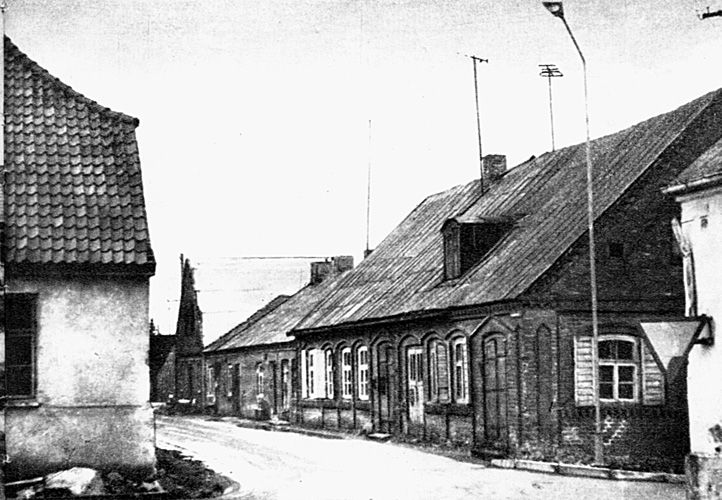
Figure 3. Zheimilis. Bauskaya Street. View from the Market square. The first house from the right was the house of Elia-Mates Chaesh. Foto of 1983.
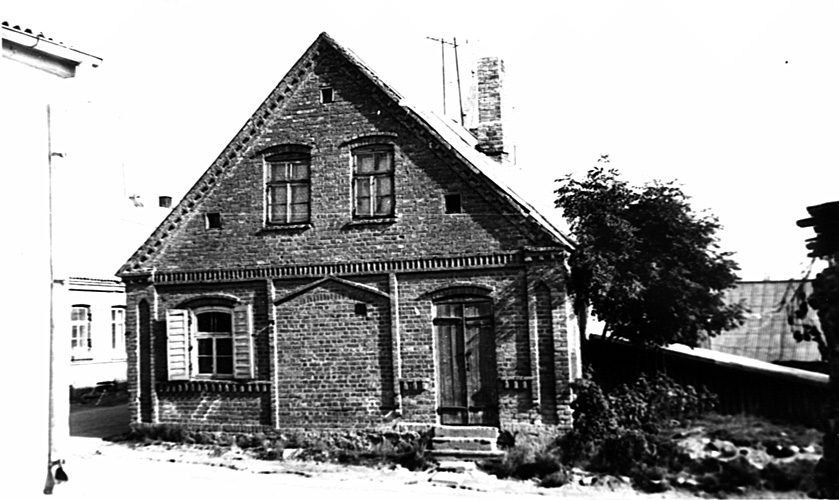
Figure 4. The house of Elia-Mates Chaesh. View from Pasvalio Street. Foto of August 31, 1982.
It follows from the book written by Aaron that Mates “was a wholesale merchant selling wood and flax. Besides, he was a manufacturer of tile [78]. He was an honest man, devoted to his activity. My mother was a housewife. She always helped her father with all his affairs. She was kind” [79]. Gradually their family happiness which had been spoilt by the fire of 1877 began to return to them. After that their family settled down in the new place.
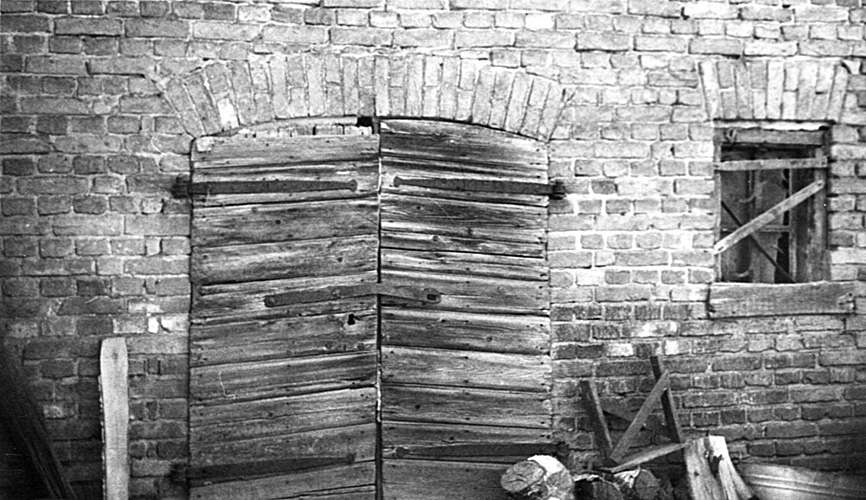
Figure 5. The house of Elia-Mates Chaesh. View of the basement from the yard. Foto taken by A. Chaesh on August 31, 1982.
Their big family was cramped in that small house, and Mates moved to the stone house as had enough money for that. That house has been preserved to our time. It is situated in the centre of the city at the intersection of Bauskaya and Pasvalio Streets. Its corner faces the Market square. When I first came to Zheimel in 1982 my father showed me the house of his grandfather [80]. Later that house belonged to Uncle Moisej and Aunt Gita. It was a single-storey house, built of red bricks without plaster. The house was notable for its beautiful figured brickwork. Its roof was gable, and, according to the old photos, tiled. The façade of the house with its 6 windows and 2 doors faces Bauskaya Street while the backside of the house with its 2 windows and the front door face Pasvalio Street. Two windows under the roof form a kind of the second storey from the backside. From the side which is on the opposite from the façade there was a big basement with a wide folding gate and a window with a bar.
“Near my grandfather’s house, – my father told me, – where Aunt Gita lived they had an orchard. I remember how we walked there. Besides, there was a yard which was even bigger than ours” [81].
In the map of Zheimel of the 18th century [82] the corner of this plot seems to be pointed already [83]. Perhaps, the brick house was built in the second half of the 19th century when several brickworks had appeared not far from that place [84]. Probably, it was built by Mates himself. He had to pull down the ramshackle house of the previous landowner. However, it can be that when Mates settled in Zheimel there was no wooden house already.
In the LVIA there has been preserved “Plan of shtetl Zheimel belonging to the estate of the landlord prince Anatolij Pavlovich Liven of Kovenskaya guberniya of Ponevezhskij uyezd. Drawn in 1897” [85]. Some parts of this plan are shown below in the figures 6 and 7.
In the explication provided for the plan the last and first names of the merchants, middle-class people or just local residents renting those plots as well as their square are given: the plot ¹ 9 the synagogue and house for prayers – 522,3 square sazhens [86], next to it – the plot ¹ 10 belonging to Matis Chaish – 432,4 square sazhens [87].
According to Aaron’s recollections his father’s family was very religious. Aaron and his brothers studied in Zheimel with the teachers best of those whom his father could find. At the same time he invited into the group children from poor families if their parents could not pay for the education of their children [88]. There children studied the following secular subjects: arithmetic, Old Hebrew and German which was very popular in Kurland at that time. In the family they spoke much German.
As for Mates he constantly studied the Torah and took regular lessons of Aggada and Galaha. From time to time prominent rabbis lived in their house, pupils came from the shtetl and its precincts. From his early childhood Aaron listened to their conversations and later even participated in them. A year before his departure for Palestine he took lessons given by young Avraham Kook [89].
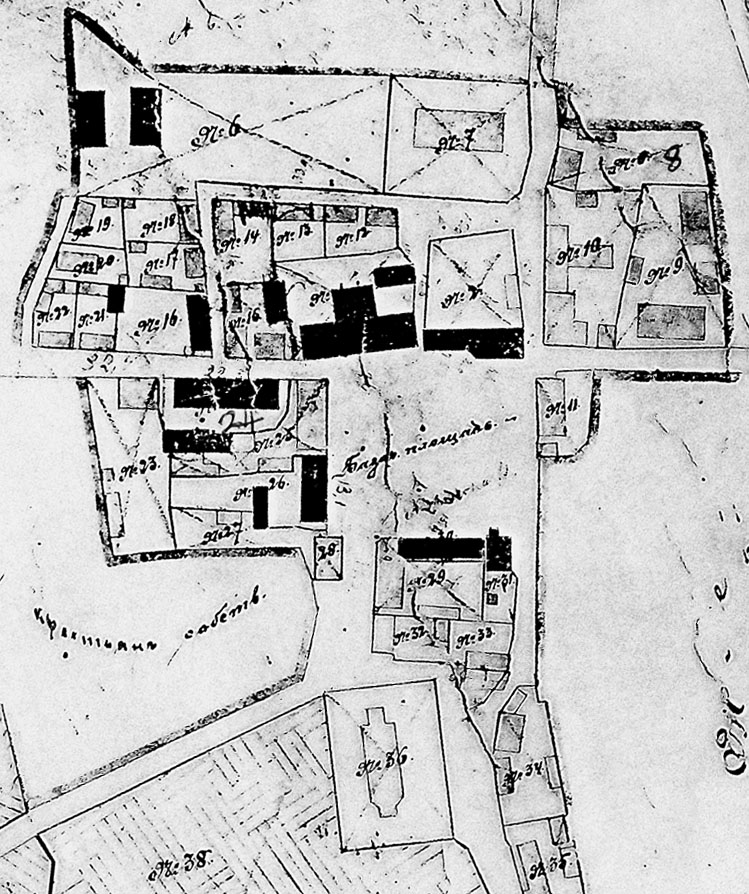
Figure 6. Plan of shtetl Zheimel, drawn in 1897 (a partial copy)
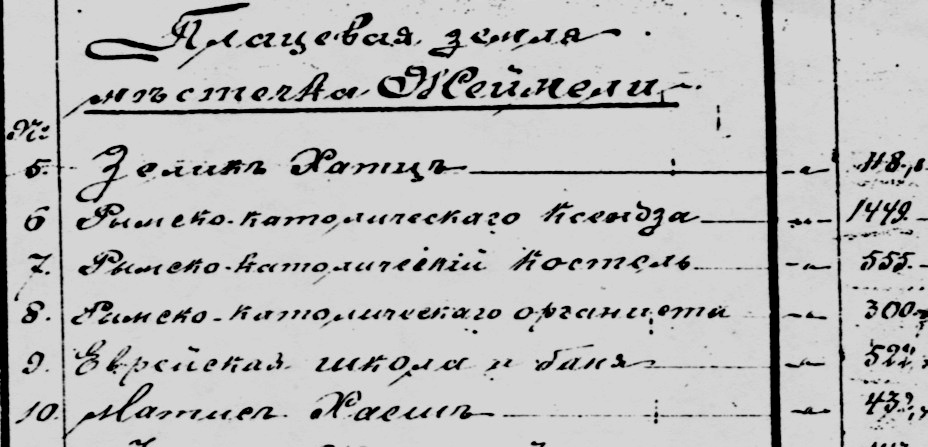
Figure 7. The upper part of the explication provided for shtetl Zheimel, drawn in 1897
The 1880s were the turning point in the history of the Russian Jews. Mass pogroms of 1881 in the South of Russia, their active support provided by different layers of local parts of Russian society, different measures taken by the government, so called “Temporary rules of May 3, 1882” [90], which were aimed not at the curb of the pogrom-makers, but at another discrimination of Jews in the view of their economic rights; all this made a great change in the views of their spiritual leaders. Earlier the representatives of new Jewish intelligentsia which emerged at the time when Alexander the second was ruling the country saw the way of solving the problem of Jews in education, getting a complete command of Russian and gradual inclusion of Jews in Russian society.
However, the reality rejected these views. Therefore the spiritual leaders of society began searching for the way of solving this problem on the basis of leaving Russia and cultural autonomy of Jews. Progressive layers of society proposed some ideas connected with the necessity of creating the Jewish state, orthodoxies urged to pray about the quickest coming of Messiah who would bring together all Jewish people and take them to the promised land as Moses did with the Jews living in Egypt.
Heated debate and conflicts between people supporting different views were raised in the local communities. As we know at that time Jewish society of Zheimel was divided into two hostile parties because they had discords connected with electing the rabbi who was to be their spiritual leader. Sometimes this dispute was so contentious that it came down to blows, smashing windows, denunciations and putting down the enemy with the help of the local Christian administration. Only Avraham Kook whose rabbinic career started in Zheimel in 1887 [91] and who was one of the first thinkers supporting the idea of departure for Palestine managed to reconcile two hostile parties.
According to Aaron it was Mates Chaesh who noticed and invited Avraham Kook from the neighbour Birzhi. Then Mates suggested the community that Avraham Kook should be elected their rabbi. This assertion seems to be quite credible as according to Aaron his father was a very friendly person. His house was open for everybody who asked for some help. Mates was on friendly terms with members of the community, he had authority with them. He was elected the “rosh of the kahal” – this way Aaron calls position of the head (gabe) of the Jewish religious society. It was quite natural that holding this high post Mates could propose the community to elect Avraham Kook their rabbi. The views of Avraham Kook on departure for Palestine were similar to the views of Mates who willingly let Aaron leave for Palestine together with his grandmother. Aaron recollected that when Mates was elected the “rosh of the kahal” meetings of the “sages” living in the shtetl were held in their house [92].
Avraam Koen Kook lived in shtetl Griva. The glorious career of this famous rabbi started in Zheimel. Mates felt that Kook would be “the star in Israel”. Later Kook really headed many communities: in Birzhi, Ekaterinoslav, was the rabbi of Jaffa and, finally, the main rabbi of Eretz-Israel.
The fact of electing Mates the head of the Jewish religious society and his collaboration with Kook is confirmed in the “Register of the Jewish couples married in 1889” of Zheimel. It was written in two languages: in Russian and Old Hebrew. However, its Russian records were not very grammatical:
“The final amount of the couples married in 1889 was five ¹ 5 I confirm it. Assistant of the Rabbi in Zheimeli Abram Ichik Kook, Head Gabbe. Matis Chaies, treasurer. <signature written with the Hebraic letters> (the signature means Bentsel Milunskij)”.
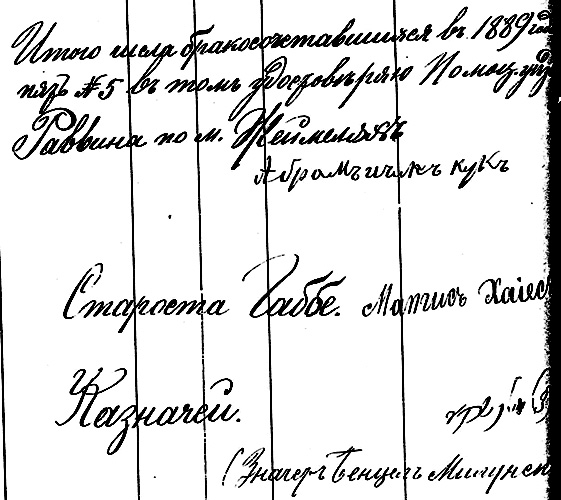
Figure 8. From the register of Zheimeli for 1889 [93]
In the same register of 1890 it is said: “The final amount of the couples married in 1890 was eight ¹ 8. I confirm it. Assistant of the Rabbi in Zheimeli A i Kook, Head gabaj M. Haies, treasurer it means Bentsel Milunskij <signature written with the Hebraic letters>” [94].
In the Jewish religious societies officials were elected for a term of three years. Since in 1891-1893 the head of the Jewish religious society of Zheimel was Wolfson we can suppose that Mates was elected its head in 1888.
Electing Mates the head of the Jewish religious society of Zheimel proves his important status and prestige with the community. At that time this status could be achieved due to the knowledge of religious books and charity. Those people who wanted to do charity needed much money. So we can conclude that the business of Mates were in good fettle.
In 1889-1895 he provided his son Aaron for the opportunity to study in the eshiva which was called “Ez-Chajim”. It was the richest and the most famous eshiva in Jerusalem [95]. Mates sent Aaron who studied there so much money that Aaron spent only some part of that money and saved the rest of it. Once there was a case in the eshiva when they did not find money for giving salaries to its workers. Then Aaron brought some part of his savings and gave them to the treasurer of the eshiva. He planed it as disinterested help. However, the treasurer said that they would immediately make out a receipt and then would return their debt with paying high interest from it. When Aaron wrote about it to his father the latter answered that Aaron should not take this money at all, but he should give all this money to the eshiva.
Occasionally Aaron came to the bank to cash his cheque. The German banker was very surprised and said: “If your father is so rich that he can send you 200 rubles at once then what are you doing in such a god-forsaken hole as Jerusalem is? You could live somewhere in Europe!”. In return Aaron objected saying that Jew should live only in Jerusalem.
In 1891 Elia-Matisjagu Chaes was mentioned among the philanthropists of the society “Lehem ha-Aniim” (Bread for Poor People) which that year was created in the shtetl [96].
In 1894 Mates was elected as the head of the Jewish religious society. In November 1894 he signs his name in the following way: “Head Gabbe. For M. Chaesh”, and from January 1895 till the end of 1896 every month he signed in the following way: “Head Gabe Mates Chaesh” [97].
According to the reference book “Vsya Rossiya na 1895 god” (“The Whole Russia of 1895”) Chaesh who lived in Zheimel had a small shop which was called “Grocery”. My father used to say that, probably, it belonged to Mates as his eldest son Lejzer did not sell anything in the shops [98].
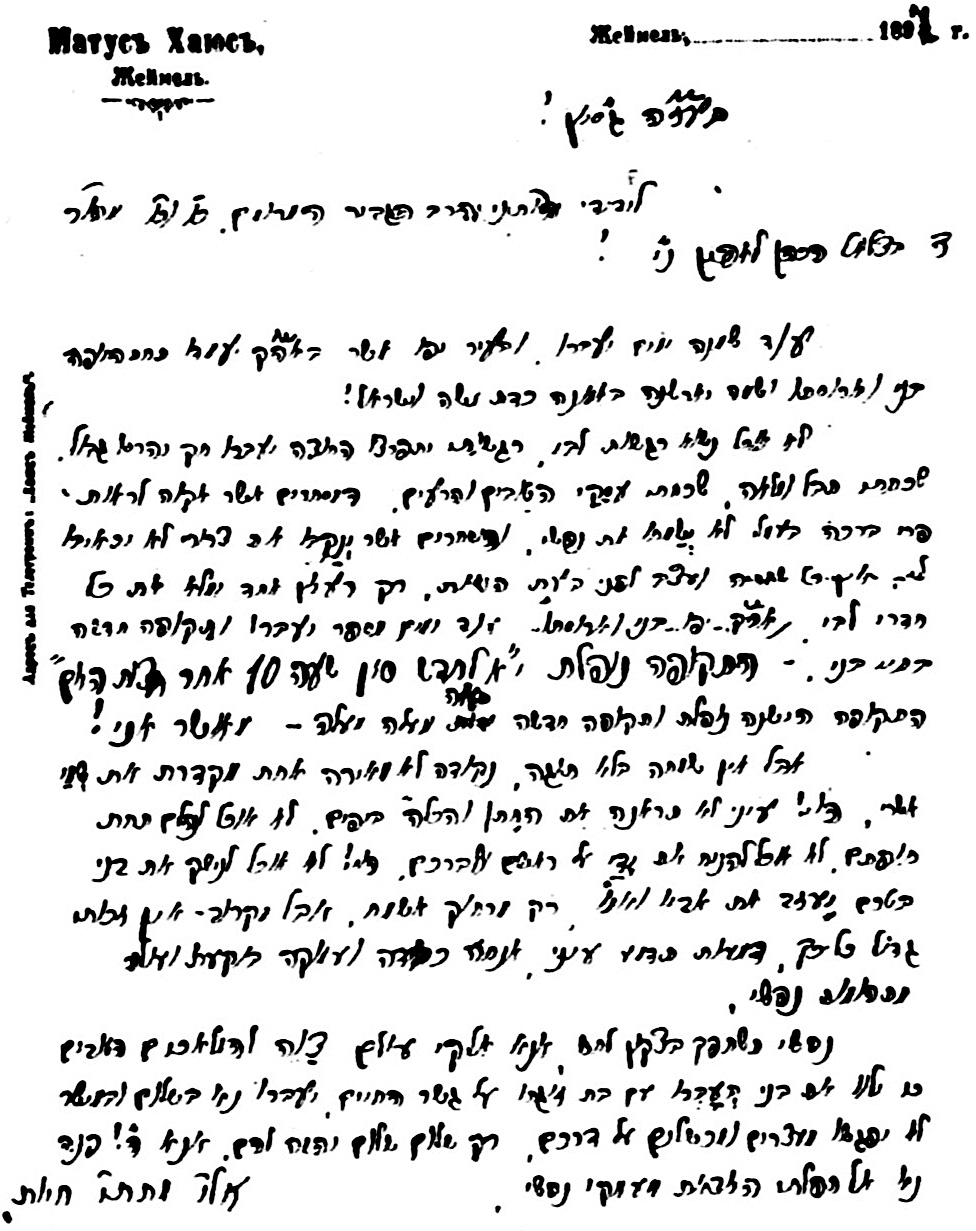
Figure 9. The letter of Elia-Mates to father of his daughter-in-law Betsalel Lapin
When the children of Mates became adult gradually they were leaving their family. In 1895 Lejzer got married. Roza got married too. She left for Riga. Frida went to Riga as well. Girsh and his cousins left for South Africa. To return the son Mates sent David for him who was accompanied by two adult compatriots. However, David was delayed in South Africa too [99].
In October 1896 Lejzer who was the eldest son of Mates got his daughter Chane. She was the first and the only granddaughter who was born when he was alive. According to my father, “Grandfather El’ja-Mates liked her very much and nursed her” [100].
In 1897 Aaron got married. Mates could not visit his wedding in Palestine because of the state of health, but he sent his greetings letter to father of his daughter-in-law Betsalel Lapin. Aaron published the photocopy of that letter in his book [101]. It is the only document which was written by Mates personally and which has been preserved to present day. My nephew Mark Moulin who has a good command of Hebrew describes its content in the following wFay:
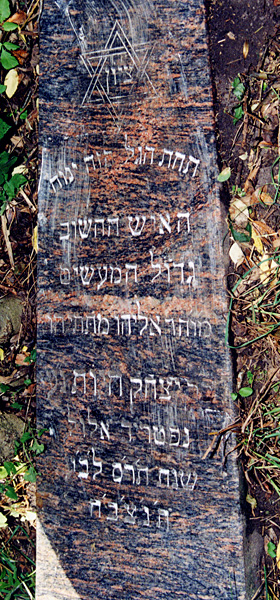
Figure 10. The grave of Mates Chaesh. Photo taken by Barry Mann. 1999“The letter is written in very grammatical Old Hebrew. In the book with the patterns of typical letters it could be used as a model of the letters of this kind. At first this letter states joy and pride for the son with the use of magnificent expressions. His father is proud that he became so adult. Moreover, in a certain sense it was the result of his independence. Then this letter says that Mates expresses regret in connection with the fact that he is ill and can’t travel there. Finally he wishes his son happiness in the future”.
In next year 1898 he and his eldest son Lejzer were mentioned in the newspaper “Gamelits” ¹ 117 as benefactors.
Mates died in 1900 or at the very beginning of 1901. Those years were enumerated by his Israeli grandsons Daniel Chajuss and Tsilja Rokman as well as by my father who was born on May 2, 1901 when Mates had already died. Barry Mann told me the exact date and place of his funeral according to the inscription on matseva which has been preserved in the Jewish cemetery of Zheimelis up to the present [102]. That date was Elul 4, 1900. Barry Mann took and sent me the photo of matseva. In 2002 the main archivist of the LVIA Galina Anatoljevna Baranova sent me a copy of the record which was left on August 7 (Elul 3), 1900. The record said about the death of Matis Itsikovich Haesh belonging to Onikshtinskoye society. According to that record he died in Zheimel because of the “inner disease” [103].
Probably, Mates bequeathed his house and plot to his wife Fejga and his eldest sons: Lejzer and Moisej who stayed with their families in Zheimel [104]. In 1910 his real estate was insured for 1100 rubles (the annual insurance payment was 5 rubles).
Fejga died much later than her husband. She was the first of my ancestors whom I describe on the basis of real evidences which I heard from those people who knew her; at the same time I almost don’t need any books or documents to write about her.
Tsilja Haesh and Rahil Kretsmer who said to me that my grandmother’s name was Fejga Markovna are not very exact as Fejga’s real patronymic name was Morthelovna [105]. However, the replacement of the Hebraic name Morthel (Mordehaj) by the Christian name Mark was a usual thing [106].
According to the granddaughter of Aaron Hajot Tsillya Rokmann Fejga’s son Girsh Chaesh who had emigrated to Johannesburg took there his mother’s surname – Blumberg since the surname “Haesh” was considered to be not very euphonious. Hence Fejga’s maiden surname was Blumberg [107]. It seems to be quite probable because in 1878 the merchants of the second guild Isaak Markovich and Veniamin Morthelevich Blumberg were living in the city Rossienyi of the same Kovenskaya guberniya. Perhaps, they were Fejga’s brothers [108].
My father agreed that the name of his grandmother was Fejga Markovna [109]. He told me the following: “I don’t remember anything about my grandmother when she lived in Zheimel. I don’t remember at all what her real name was. I remember that she was a spare, sturdy and grey-haired old woman. May be, she wanted to fondle me and other children but I don’t remember any moments when she could fondle me. We had nannies. In any way I had a nanny when I was a little child”. One may assume that my father’s grandmother rarely visited their house. Probably, she did not maintain close relationships with Frejda, my father’s mother. It follows from his further recollections.
Tsilja Moiseevna Chaesh who was 10 years younger than my father (she was born in 1911) remembered my grandmother much better: “In the yard of Moisej’s house, just on the opposite from our back entrance there was a small single-storey house of our grandmother, our father’s mother. She was a very meek old woman, not tall, very tidy, she used to wear a small clean wig, before going to bed she took it off. However, her behaviour was quite independent. She lived in her own wing of the house. I ran up to her. Her small wing was wooden, it was located in the yard” [110].
On May 5, 1915 all the Jews were evacuated from Zhemel. Finally families of Fejga’s sons – Lejzer, Moisej and Isaak – came to Penza [111].
Figure 11. Fejga Morthelovna ChaeshMy father told the following: “In Penza our grandfather lived together with us. With my father. May be, she lived with Uncle Moisej as well. She was a very quiet, kind, small and slim old woman. I can’t say if she left Zheimel together with our family, but I know that she lived in Penza. I remember that she was a spare, sturdy old woman, she didn’t offend anybody. There she was offended, but I don’t remember in what way. I had many other troubles to worry about. I take much offence, probably, mostly at my mother who didn’t pay proper attention to our grandmother. By the way, all her children were in Penza. However, I should say frankly that the children were not very good. Probably, our grandmother was very oppressed by everybody, and I felt sorry for her. Therefore our grandmother, this old woman, when the First Imperialistic War finished she decided to leave the children herself. After all she was the first who went back to Zheimel in 1918 as soon as it became possible <to return> earlier than other members of her family because living with the children was worst of all for her… She decided that in her old age she felt bad and that there she would feel good. I even can’t understand how this old woman got there without knowledge of the language or anything else. Perhaps, somebody left back for Lithuania, and she left with that person. It is obvious that there she died, the lonely old woman. What could she do there being alone?” [112].
Tsilja Chaesh tells about her grandmother living in Penza: “During a week she had been living with one of her sons. Then we accompanied her to another son, then to the third one. So she wandered. I say: “Granny, don’t leave us” And she answered: “I don’t want to trouble anybody. Accompany me, please”. When all the refugees were allowed to return she didn’t want to live with anybody. She left for her small wooden house, to Zhemel” [113].
Besides, I heard a sad story about the lost months of Fejga’s life, told by Fajvl Zgorskij [114]:
“Lejzer and Mejshe <that is Moisej>, – Fajvl tells me, – lived in Penza together with their mother who was your great-grandmother. At that time I was seven-eight years old, and I didn’t remember her name. <I reminded him that my great-grandmother’s name was Fejga>. There was a refugee from Zheimel who was living in Penza at the same time. Her name was Sora Abramovich and she was a widow with five daughters. Certainly, Lejzer and Mejshe knew her: all of them were from the same shtetl. In 1918 Sora was returning to Lithuania. For Fejga to be able to return to Zheimel her sons handed her over to Sora, but didn’t take her there themselves. Fejga was everbotel***, she didn’t remember anything, she was an eighty-years-old woman. Probably, she was a burden on them. Sora was poor. Lejzer and Mejshe gave her some money. Apparently, they had some business there as they were men, and it is very likely that they took that money there with them.
We returned to Zheimeli from Tambov in August 1918. Two-three months after us Sora Abramovich and Fejga arrived there too. Sora thought that Lejzer and Mejshe would come right after them, but they didn’t come. At that time we were living near the Lutheran church. Sora was our neighbour. Fejga was lying in her house. She didn’t understand already where she was. She used to call: “Mejshe! Lejzer!” Old people – everbotel. Her sons could come together with their mother. Why did they need to send her earlier than they could come there? Well, probably, they didn’t settle some affairs.
Sora was plagued by Fejga. The widow was helpless, as a woman she wasn’t determined to come to the rabbi to consult with him. My father was still their neighbour; besides, he was a man. Sora came and ask him: “Josif, go and ask the rabbi what to do with her? I thought that she was handed me over just for some time, and they don’t go for weeks and even months. I don’t know already what to feed her with”.
I remember that moment when my father went to the rabbi. One might say that Fejga was a rich person. He said: “She is lying in the house of some woman, and her children left her. What should we do with her?”. The rabbi answered: “What can I do? Let that person who got this misfortune take trouble over it. They <Lejzer, Moisej> will come”.
However, Fejga couldn’t wait till their arrival. I remembered only all this fuss, that they handed their mother over to Sora, that they didn’t accompany Fejga on the way from Penza to Zheimel themselves, but handed their mother over to the widow; I remembered that she died, and only later Lejzer came there, and Mejshe, probably, stayed there.
Fejga was buried in winter 1919. My father died in spring 1919, perhaps, in May. As for Fejga she died two-three months before that, in winter” [115].
Tsilja Chaesh whom I retold Zagorskij’s story said the following:
“The children persuaded our grandmother not to return alone. Lejzer wanted to return too. He was a practical person, he didn’t like when something slipped away. As for my father he was an easy-going person, Lejzer’s absolute antipode. The children asked our grandmother at least to wait till the moment when Lejzer goes there. That story which was told by Fajvl Zagorskij is not very correct. Isaak was poorer than other people leaving there, and my mother possessed generous nature. She wouldn’t let our grandmother go without money. May be, our granny wasn’t given too much money as Lejzer was supposed to go soon after her, but it is obvious that they couldn’t say goodbye to her without giving some money to her” [116].
14. Chaesh, or Chaes, Chaish Ber (Berel Itsikovich) 6
During long time I did not know neither when Ber was born, nor when he died. In the registers of Zheimel there has been preserved only one record saying that on January 7, 1879 in the estate Geduts Ber Itsikovich Chaesh and his wife Gita Lejzerovna belonging to the community of Zheimel got the son whose name was Girsh-Lejzer [117]. According to the patronymic names they had other children too: Enta [118] who was born in 1877 and Frejda who was born in 1885 [119].
Geduts, or, rather, Geduchi is an estate in Natsunskaya volost’ which is situated on the way from Zheimel to the shtetl which is called Konstantinovo, near the same brook Planit – as well Libedzi [120]. It means that Ber lived not far from Mates. At the end of the 18th century the proprietress of the estate Geduts was the land-owning lady Elisaveta Eleonora von Grotguz (Grotuz, Grottuz). After Eleonora’s death these estates were handed down to her granddaughter who got married to Karl Brunov. He owned the estate Gedutse as early as in 1849 [121]. The square of that estate was more than 850 desyatinas including 560 desyatinas of forests (one desyatina is equal to 1.09 hectares). The estate was pledged in the Society of Land Credit for 25000 rubles. Quite often it pass through many hands: in 1865 it was bought by the merchant of the second guild living in Riga – Teodor Gar – from Baron Fyodor Tornau, in 1876 he sold Baron Adam Adamovich Koskulya this estate; the latter sold Baron Frants Wilgelmovich Gan this estate again. In 1899 his son Georgij Frantsevich Gan sold Kuno Pavlovich Gan this estate [122]. Hence we can say exactly that Ber Chaesh lived in the estate when Baron Koskulya owned it and, perhaps, when somebody else possessed the estate.
Later it was revealed that during the First general census of the population which was conducted in 1896 the petty bourgeois of Zheimel Berel Itsikovich Chaish who was 48 years old and who lived in his own wooden house [123]. The house was located in shtetl Konstantinovo on Gruzhonskaya Street. So Berel was born in 1848. Some people lived together with him. These were: his wife Gisa Bereleva who was 45 years old (that is she was born in 1851), – both of them were illiterate; their son Lejzer who was 17 years old (he was born in 1879); their daughter Frejda who was 14 years old (she was born in 1882) and their son David who was 11 years old (he was born in 1885).
In December 2006 Barry Mann retold me the content of the registration statements saying about the birth of two sons by Ber and Gisa. According to these documents the first of them, David Idel Chaesh, was born in Zheimel on January 28, 1883 [124]; it is evident that their second son, Itsik Chaes, got this name after his late grandfather was born in Zheimel on January 24, 1886 [125].
Since Gita died in 1878 it becomes clear after comparing the members of those families that Ber Itsikovich Haesh moved to Konstantinovo by 1896 [126]. In the questionnaire used for the census his main occupation is designated as “merchant”, and the main occupation of his daughter is designated as “in the small shop”. So being a petty bourgeois Ber who was occupied with selling dairy produce and therefore he considered himself to be a merchant.
In 1907 we find the name of Ber Itsikovich in the list of voters electing the deputies of the Third State Duma. He got his right to vote as he was a house-owner in Konstantinovo [127]. I don’t know anything about his further destiny.
15. Chaesh Wolf Itsikovich 6
Wolf was born approximately in 1859. It is evident from the preserved record of his death in village Kemyanyi on December 16, 1865 when he was 6 years old. His death was caused by disease. Wolf was buried in Zheimel [128].
16. Chaesh Gavriel Itsikovich 6
Gavriel was born in Zheimel on February 17, 1860 [129]. There he fell sick and died on April 17, 1860 [130].
17. Chaes (Chaesh) Ur’jash Itsikovich 6
I found two records in the registers of shtetl Posvol, which are connected with Ur’jash. My grandmother and her sister came from the same shtetl. In the first record it is said that in shtetl Konstantinovo the petty bourgeois from Zheimel Ur’jash Itsikovich Chaes and Tsipa Izrailovna got the son on December 27, 1886. His name was Iosel. The second record says that on July 1, 1908 the petty bourgeois from Zheimel Ur’jash Itsikovich Chaes and Tsipa Izrailova whose maiden surname was Chaesh got the son whose name was Izrael [131]. Thus Ur’jash was married to the daughter of his first cousin. Moreover, he and his family were as usual registered at the community of Zheimel, but lived in shtetl Konstantinovo.
In 1906 and 1907 Urij Itsikov Chaesh was included in the lists of voters living in shtetl Konstantinovo and electing the deputies of the Second and the Third State Dumas as he was a merchant of the third class [132]. He did not have real estate and, perhaps, lived in the house of his brother Ber.
In 1916 Urij came to Samara. The historians of that city write the following: “In connection with serious economic upheavals a dangerous disease appeared in the city. The disease is rise in prices. According to the governor’s decree the police began their ruthless fight against the plunderers of provisions and speculator. From the capital Ministry of Internal Affairs they sent different dispatches where they demanded to find people who tried to become rich during the war and to arrest them immediately. In June 1916 the policeman demanded from the owners of warehouses to give an account of the amount of sugar which they kept. Salt, matches, poor tobacco and spirit were declared to be strategic raw materials. Speculating in these goods was suppressed. Okolotochnyijs (that is policemen of the city) walked along the yards, conducted searches of cellars, sheds and attics trying to find hidden goods which had not been registered. For example, in the woodshed in the yard of the petty bourgeois Urija Itskov Chaesh they found 7 sacks of poor tobacco; 6 sacks were found in his grocery. Besides, there they found 11 boxes of snuff (every of them weighed one pood****) and 10 boxes of matches. All this took place at number 34 Sadovaya Street. Okolotochnyijs gave a report. The head of local police wrote there himself: “For confiscating”” [133].
We don’t know anything about further destiny of Urija.
18. Haesh Pejsah Itsikovich 6
For the first mention his name is mentioned in the list of Jews living outside the towns and shtetls of Natsunskaya volost’. It is said there that Pejsah’s family consisted of his wife Chana, their son Efroim and two daughters: Frida and Chaya-Tsile [134]. Since 1893 their family lived in village Javojshi [135]. It is evident from the documents of 1909 that then their family moved to Zheimel. Pejsah solicited for getting money to pay for accepting his son Efrem to the clinic for the mentally sick people “Gyuntershof” in Kurlyand. Pejsah’s daughter Shifra Chaesh signed the application as Pejsah was illiterate [136].
19. Chaesh (Chaes) Lipman Pejsah Itsekovic 6 (?)
We have very a few data about him. In December 2006 Barry Mann sent me the content of two registration statements. The first of them informs about the fact that the daughter of Lipe Chaesh and Hana-Rejza (both of them belonged to the community of Zheimel) Elka-Matlya was born in Zheimel on January 5, 1901. The second one says that the son of Lipman Itsikovich Chaes and Chana-Rejza Itsek-Fajvush was born in Zheimel on October 21, 1896. However, it seems to be doubtful that Itsik Davidovich (¹ 6) was Lipman’s father.
20. Chaish Dvejra Davidovna ?
We have only her death certificate. It says that she died because of fever in Konstantinovo parish on August 21 (Elul 26) of 1869 when she was two years old [137]. So she was born in 1867. She was buried in Zheimel. We don’t know anything about her father David Chaish.
The translator’s comments
* Volost’, uyezd and guberniya were the main units of administrative division in tsarist Russia: the smallest of them was volost’, then – uyezd (more or less similar to district in other countries) and the biggest unit was guberniya (more or less similar to province in other countries).
** Stan – an administrative and police subdivision of uyezd. Th chief of stan was called “pristav”, or “stanovoj pristav” if they wanted to emphasize the difference of stanovoj pristav from uchastkovyij pristav. The latter was the chief of a police-station in the city. Tyisyatskijs were elected by those people who lived in villages or shtetls. The main duty of tyisyatskijs was to provide assistance for the police as at that time not too many people were on the staff in the police.
*** Everbotel – an Yiddish word which means “a person who became senile, a person who lost possession of his or her faculties”.
**** Pood – a weight measure in old Russia (1 pood is equal to 16.38 kilograms).
